Analyzing Pay Scale as a Key Motivator for Employee Performance
VerifiedAdded on 2023/04/25
|11
|2987
|264
Essay
AI Summary
This essay examines the extent to which pay scale serves as the primary motivator for employees in contemporary corporate settings. It discusses the universally acknowledged influence of pay on employee performance, linking earning potential to improved lifestyles and increased productivity through incentive-oriented targets. The essay highlights positive feedback from employees regarding fair compensation and its impact on loyalty and responsibility. It also addresses alternative perspectives, noting that factors such as job satisfaction, workplace environment, and leadership skills play crucial roles in employee motivation, and that overemphasis on monetary incentives can lead to burnout and compromised work quality. The essay concludes by advocating for a balanced approach that combines fair pay with non-monetary rewards, recognition, and a supportive work environment to foster employee engagement and overall organizational success. Desklib offers a wide array of solved assignments and study materials to aid students in their academic pursuits.
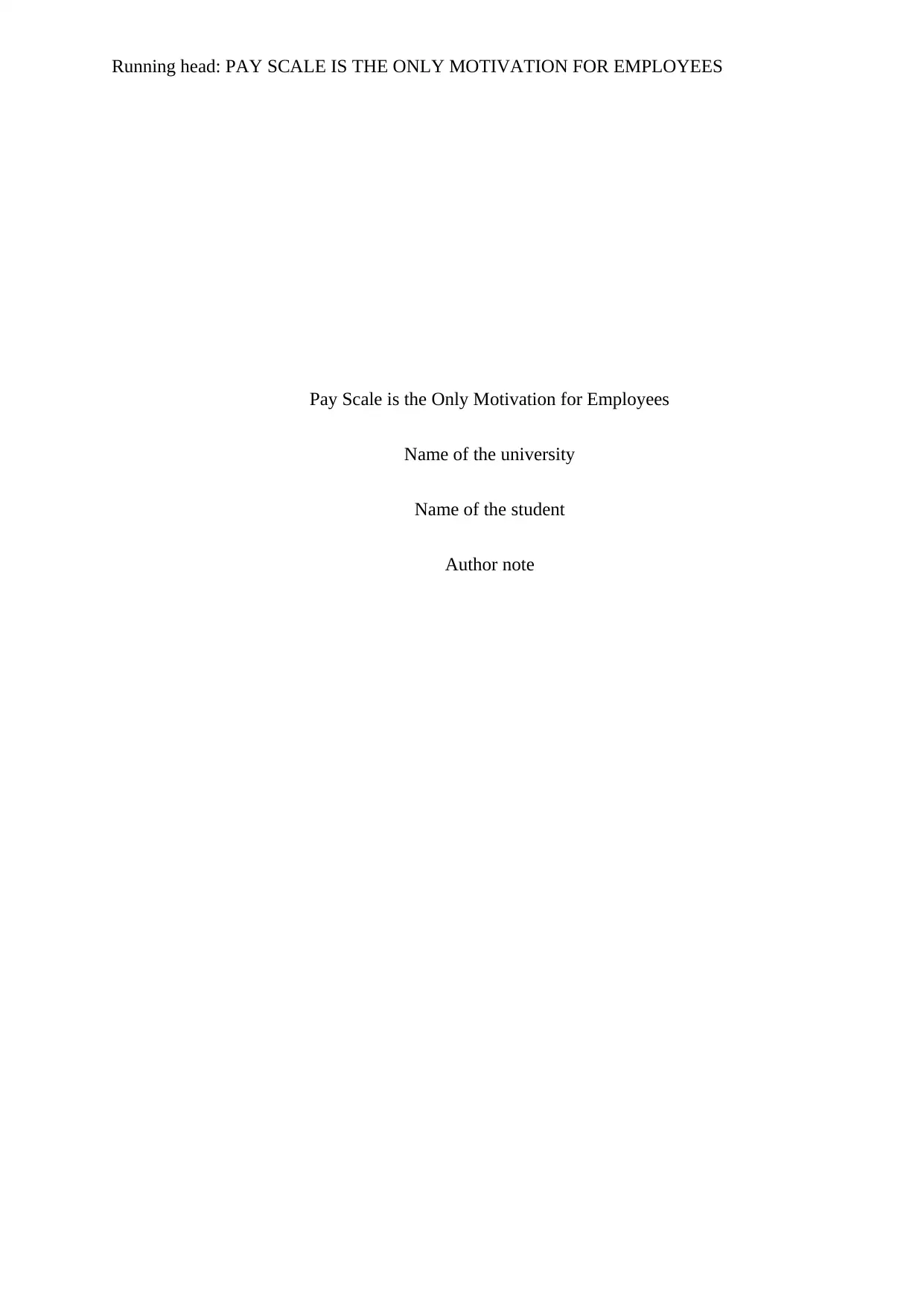
Running head: PAY SCALE IS THE ONLY MOTIVATION FOR EMPLOYEES
Pay Scale is the Only Motivation for Employees
Name of the university
Name of the student
Author note
Pay Scale is the Only Motivation for Employees
Name of the university
Name of the student
Author note
Paraphrase This Document
Need a fresh take? Get an instant paraphrase of this document with our AI Paraphraser
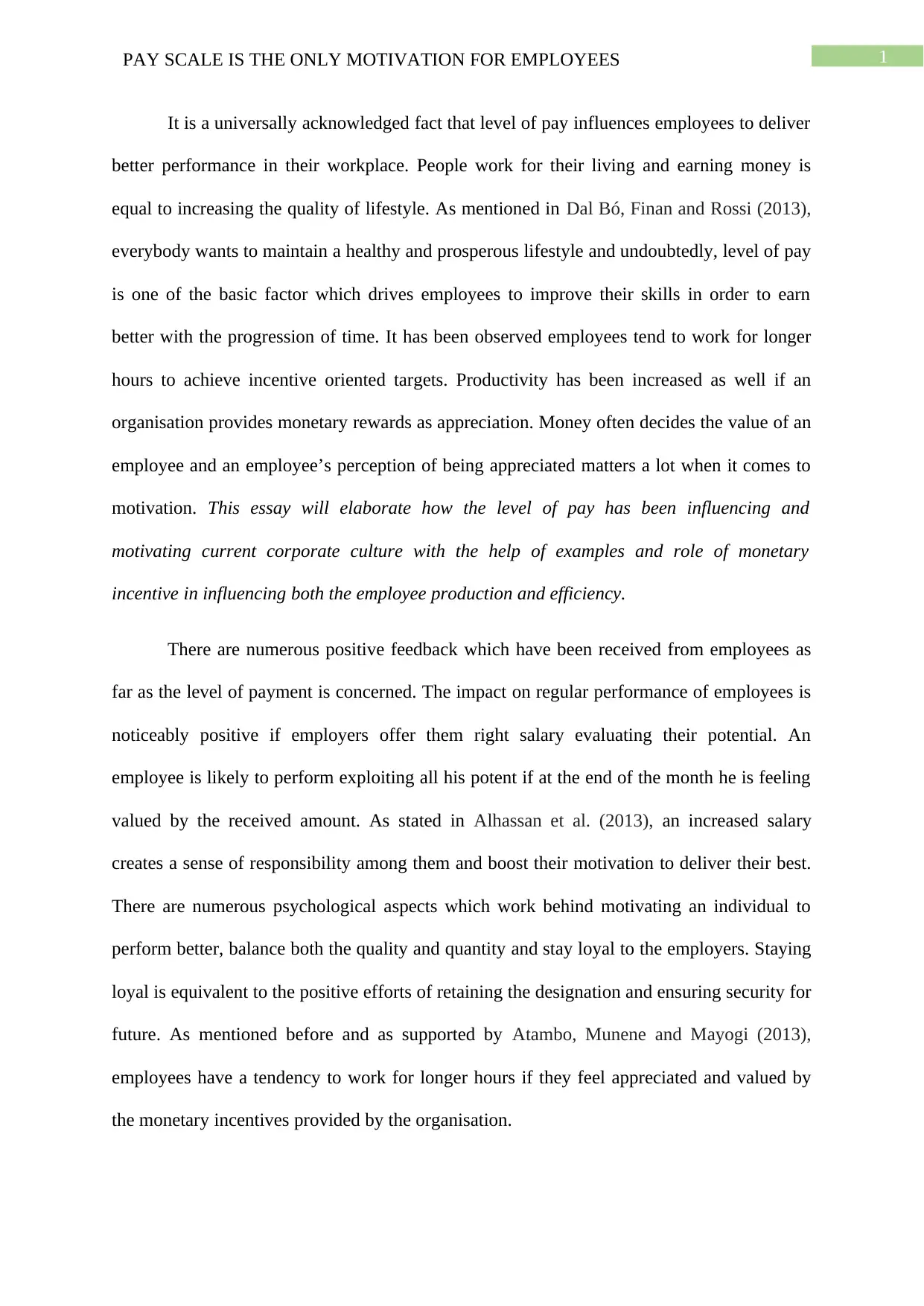
1PAY SCALE IS THE ONLY MOTIVATION FOR EMPLOYEES
It is a universally acknowledged fact that level of pay influences employees to deliver
better performance in their workplace. People work for their living and earning money is
equal to increasing the quality of lifestyle. As mentioned in Dal Bó, Finan and Rossi (2013),
everybody wants to maintain a healthy and prosperous lifestyle and undoubtedly, level of pay
is one of the basic factor which drives employees to improve their skills in order to earn
better with the progression of time. It has been observed employees tend to work for longer
hours to achieve incentive oriented targets. Productivity has been increased as well if an
organisation provides monetary rewards as appreciation. Money often decides the value of an
employee and an employee’s perception of being appreciated matters a lot when it comes to
motivation. This essay will elaborate how the level of pay has been influencing and
motivating current corporate culture with the help of examples and role of monetary
incentive in influencing both the employee production and efficiency.
There are numerous positive feedback which have been received from employees as
far as the level of payment is concerned. The impact on regular performance of employees is
noticeably positive if employers offer them right salary evaluating their potential. An
employee is likely to perform exploiting all his potent if at the end of the month he is feeling
valued by the received amount. As stated in Alhassan et al. (2013), an increased salary
creates a sense of responsibility among them and boost their motivation to deliver their best.
There are numerous psychological aspects which work behind motivating an individual to
perform better, balance both the quality and quantity and stay loyal to the employers. Staying
loyal is equivalent to the positive efforts of retaining the designation and ensuring security for
future. As mentioned before and as supported by Atambo, Munene and Mayogi (2013),
employees have a tendency to work for longer hours if they feel appreciated and valued by
the monetary incentives provided by the organisation.
It is a universally acknowledged fact that level of pay influences employees to deliver
better performance in their workplace. People work for their living and earning money is
equal to increasing the quality of lifestyle. As mentioned in Dal Bó, Finan and Rossi (2013),
everybody wants to maintain a healthy and prosperous lifestyle and undoubtedly, level of pay
is one of the basic factor which drives employees to improve their skills in order to earn
better with the progression of time. It has been observed employees tend to work for longer
hours to achieve incentive oriented targets. Productivity has been increased as well if an
organisation provides monetary rewards as appreciation. Money often decides the value of an
employee and an employee’s perception of being appreciated matters a lot when it comes to
motivation. This essay will elaborate how the level of pay has been influencing and
motivating current corporate culture with the help of examples and role of monetary
incentive in influencing both the employee production and efficiency.
There are numerous positive feedback which have been received from employees as
far as the level of payment is concerned. The impact on regular performance of employees is
noticeably positive if employers offer them right salary evaluating their potential. An
employee is likely to perform exploiting all his potent if at the end of the month he is feeling
valued by the received amount. As stated in Alhassan et al. (2013), an increased salary
creates a sense of responsibility among them and boost their motivation to deliver their best.
There are numerous psychological aspects which work behind motivating an individual to
perform better, balance both the quality and quantity and stay loyal to the employers. Staying
loyal is equivalent to the positive efforts of retaining the designation and ensuring security for
future. As mentioned before and as supported by Atambo, Munene and Mayogi (2013),
employees have a tendency to work for longer hours if they feel appreciated and valued by
the monetary incentives provided by the organisation.
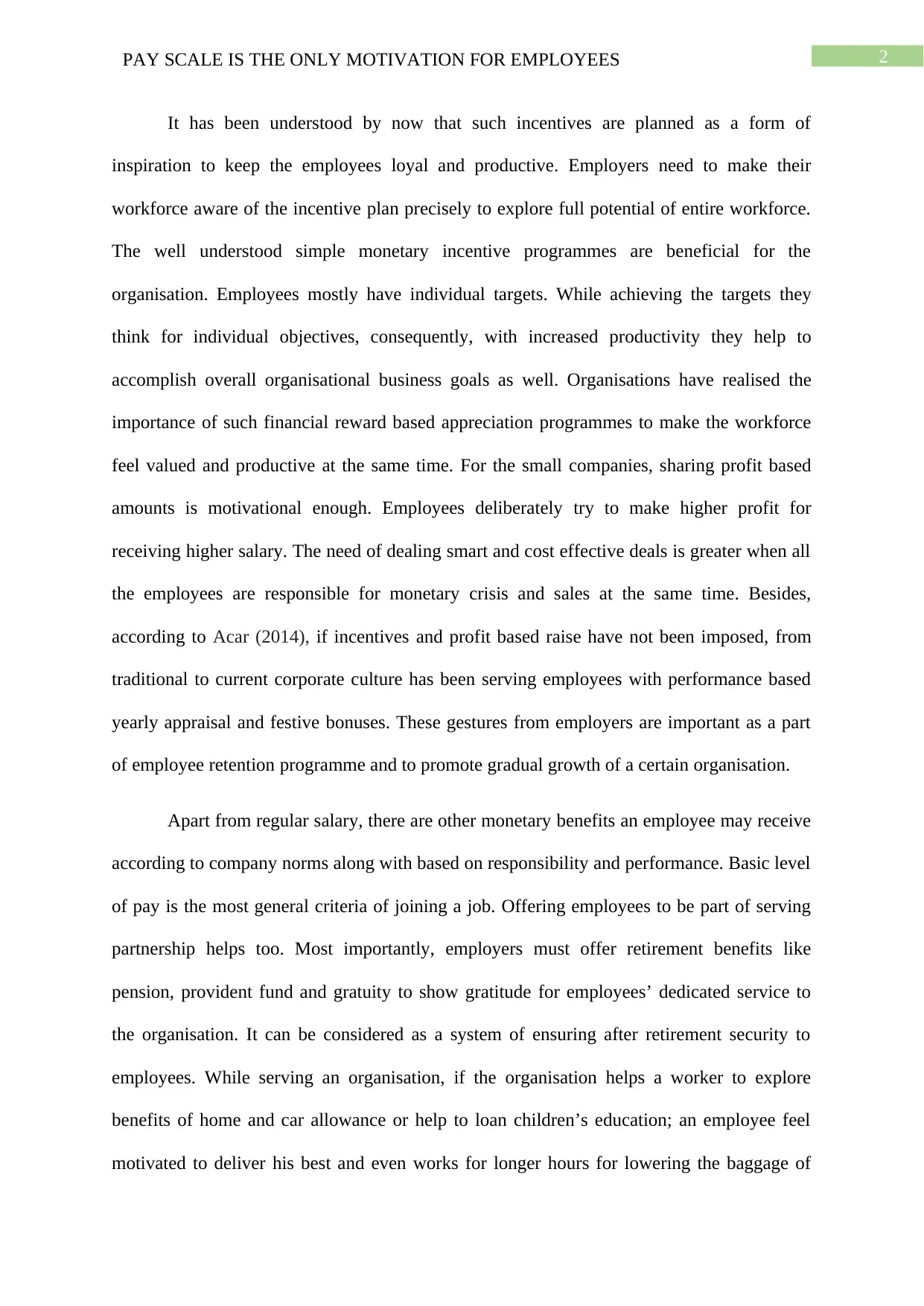
2PAY SCALE IS THE ONLY MOTIVATION FOR EMPLOYEES
It has been understood by now that such incentives are planned as a form of
inspiration to keep the employees loyal and productive. Employers need to make their
workforce aware of the incentive plan precisely to explore full potential of entire workforce.
The well understood simple monetary incentive programmes are beneficial for the
organisation. Employees mostly have individual targets. While achieving the targets they
think for individual objectives, consequently, with increased productivity they help to
accomplish overall organisational business goals as well. Organisations have realised the
importance of such financial reward based appreciation programmes to make the workforce
feel valued and productive at the same time. For the small companies, sharing profit based
amounts is motivational enough. Employees deliberately try to make higher profit for
receiving higher salary. The need of dealing smart and cost effective deals is greater when all
the employees are responsible for monetary crisis and sales at the same time. Besides,
according to Acar (2014), if incentives and profit based raise have not been imposed, from
traditional to current corporate culture has been serving employees with performance based
yearly appraisal and festive bonuses. These gestures from employers are important as a part
of employee retention programme and to promote gradual growth of a certain organisation.
Apart from regular salary, there are other monetary benefits an employee may receive
according to company norms along with based on responsibility and performance. Basic level
of pay is the most general criteria of joining a job. Offering employees to be part of serving
partnership helps too. Most importantly, employers must offer retirement benefits like
pension, provident fund and gratuity to show gratitude for employees’ dedicated service to
the organisation. It can be considered as a system of ensuring after retirement security to
employees. While serving an organisation, if the organisation helps a worker to explore
benefits of home and car allowance or help to loan children’s education; an employee feel
motivated to deliver his best and even works for longer hours for lowering the baggage of
It has been understood by now that such incentives are planned as a form of
inspiration to keep the employees loyal and productive. Employers need to make their
workforce aware of the incentive plan precisely to explore full potential of entire workforce.
The well understood simple monetary incentive programmes are beneficial for the
organisation. Employees mostly have individual targets. While achieving the targets they
think for individual objectives, consequently, with increased productivity they help to
accomplish overall organisational business goals as well. Organisations have realised the
importance of such financial reward based appreciation programmes to make the workforce
feel valued and productive at the same time. For the small companies, sharing profit based
amounts is motivational enough. Employees deliberately try to make higher profit for
receiving higher salary. The need of dealing smart and cost effective deals is greater when all
the employees are responsible for monetary crisis and sales at the same time. Besides,
according to Acar (2014), if incentives and profit based raise have not been imposed, from
traditional to current corporate culture has been serving employees with performance based
yearly appraisal and festive bonuses. These gestures from employers are important as a part
of employee retention programme and to promote gradual growth of a certain organisation.
Apart from regular salary, there are other monetary benefits an employee may receive
according to company norms along with based on responsibility and performance. Basic level
of pay is the most general criteria of joining a job. Offering employees to be part of serving
partnership helps too. Most importantly, employers must offer retirement benefits like
pension, provident fund and gratuity to show gratitude for employees’ dedicated service to
the organisation. It can be considered as a system of ensuring after retirement security to
employees. While serving an organisation, if the organisation helps a worker to explore
benefits of home and car allowance or help to loan children’s education; an employee feel
motivated to deliver his best and even works for longer hours for lowering the baggage of
⊘ This is a preview!⊘
Do you want full access?
Subscribe today to unlock all pages.

Trusted by 1+ million students worldwide
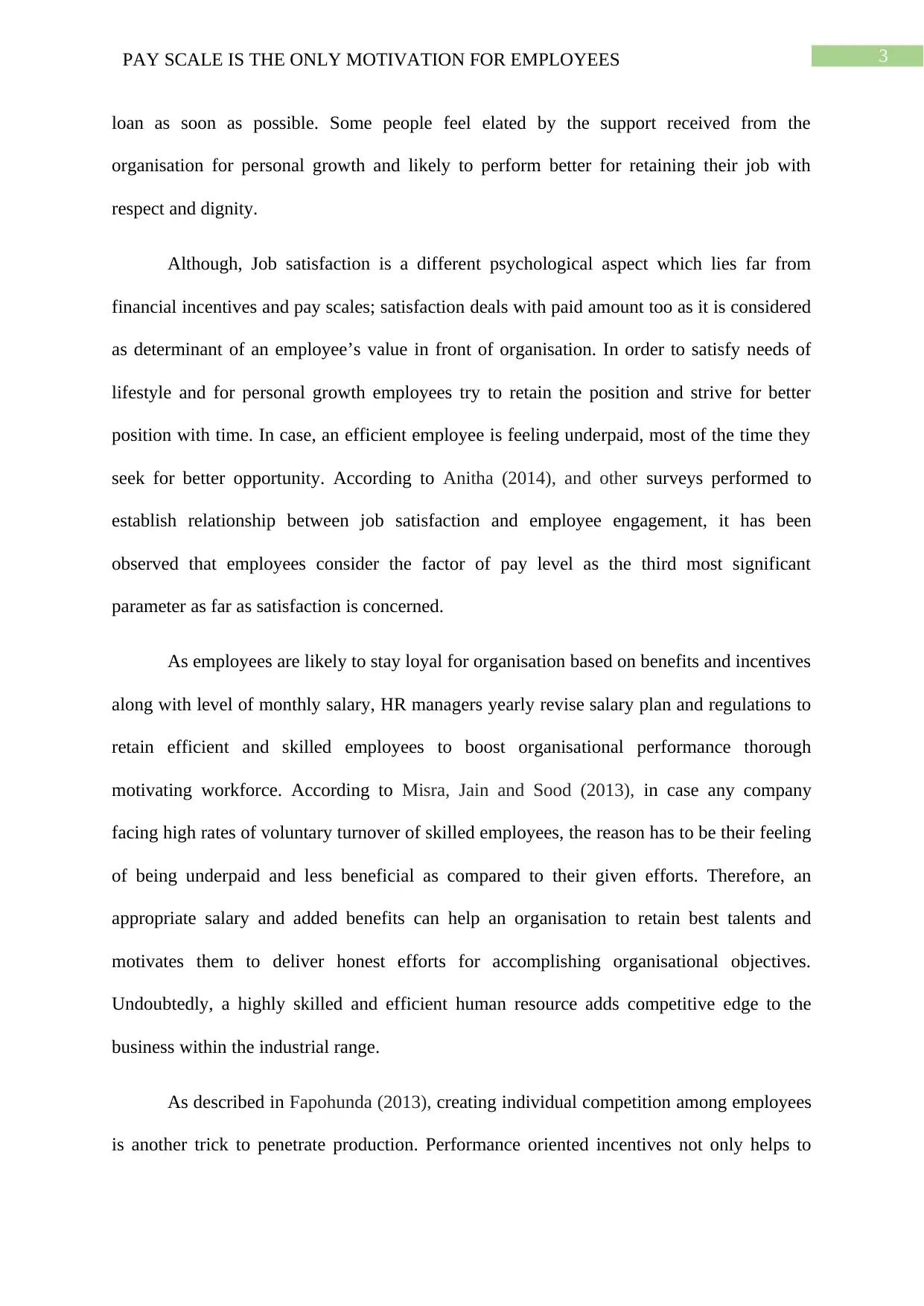
3PAY SCALE IS THE ONLY MOTIVATION FOR EMPLOYEES
loan as soon as possible. Some people feel elated by the support received from the
organisation for personal growth and likely to perform better for retaining their job with
respect and dignity.
Although, Job satisfaction is a different psychological aspect which lies far from
financial incentives and pay scales; satisfaction deals with paid amount too as it is considered
as determinant of an employee’s value in front of organisation. In order to satisfy needs of
lifestyle and for personal growth employees try to retain the position and strive for better
position with time. In case, an efficient employee is feeling underpaid, most of the time they
seek for better opportunity. According to Anitha (2014), and other surveys performed to
establish relationship between job satisfaction and employee engagement, it has been
observed that employees consider the factor of pay level as the third most significant
parameter as far as satisfaction is concerned.
As employees are likely to stay loyal for organisation based on benefits and incentives
along with level of monthly salary, HR managers yearly revise salary plan and regulations to
retain efficient and skilled employees to boost organisational performance thorough
motivating workforce. According to Misra, Jain and Sood (2013), in case any company
facing high rates of voluntary turnover of skilled employees, the reason has to be their feeling
of being underpaid and less beneficial as compared to their given efforts. Therefore, an
appropriate salary and added benefits can help an organisation to retain best talents and
motivates them to deliver honest efforts for accomplishing organisational objectives.
Undoubtedly, a highly skilled and efficient human resource adds competitive edge to the
business within the industrial range.
As described in Fapohunda (2013), creating individual competition among employees
is another trick to penetrate production. Performance oriented incentives not only helps to
loan as soon as possible. Some people feel elated by the support received from the
organisation for personal growth and likely to perform better for retaining their job with
respect and dignity.
Although, Job satisfaction is a different psychological aspect which lies far from
financial incentives and pay scales; satisfaction deals with paid amount too as it is considered
as determinant of an employee’s value in front of organisation. In order to satisfy needs of
lifestyle and for personal growth employees try to retain the position and strive for better
position with time. In case, an efficient employee is feeling underpaid, most of the time they
seek for better opportunity. According to Anitha (2014), and other surveys performed to
establish relationship between job satisfaction and employee engagement, it has been
observed that employees consider the factor of pay level as the third most significant
parameter as far as satisfaction is concerned.
As employees are likely to stay loyal for organisation based on benefits and incentives
along with level of monthly salary, HR managers yearly revise salary plan and regulations to
retain efficient and skilled employees to boost organisational performance thorough
motivating workforce. According to Misra, Jain and Sood (2013), in case any company
facing high rates of voluntary turnover of skilled employees, the reason has to be their feeling
of being underpaid and less beneficial as compared to their given efforts. Therefore, an
appropriate salary and added benefits can help an organisation to retain best talents and
motivates them to deliver honest efforts for accomplishing organisational objectives.
Undoubtedly, a highly skilled and efficient human resource adds competitive edge to the
business within the industrial range.
As described in Fapohunda (2013), creating individual competition among employees
is another trick to penetrate production. Performance oriented incentives not only helps to
Paraphrase This Document
Need a fresh take? Get an instant paraphrase of this document with our AI Paraphraser
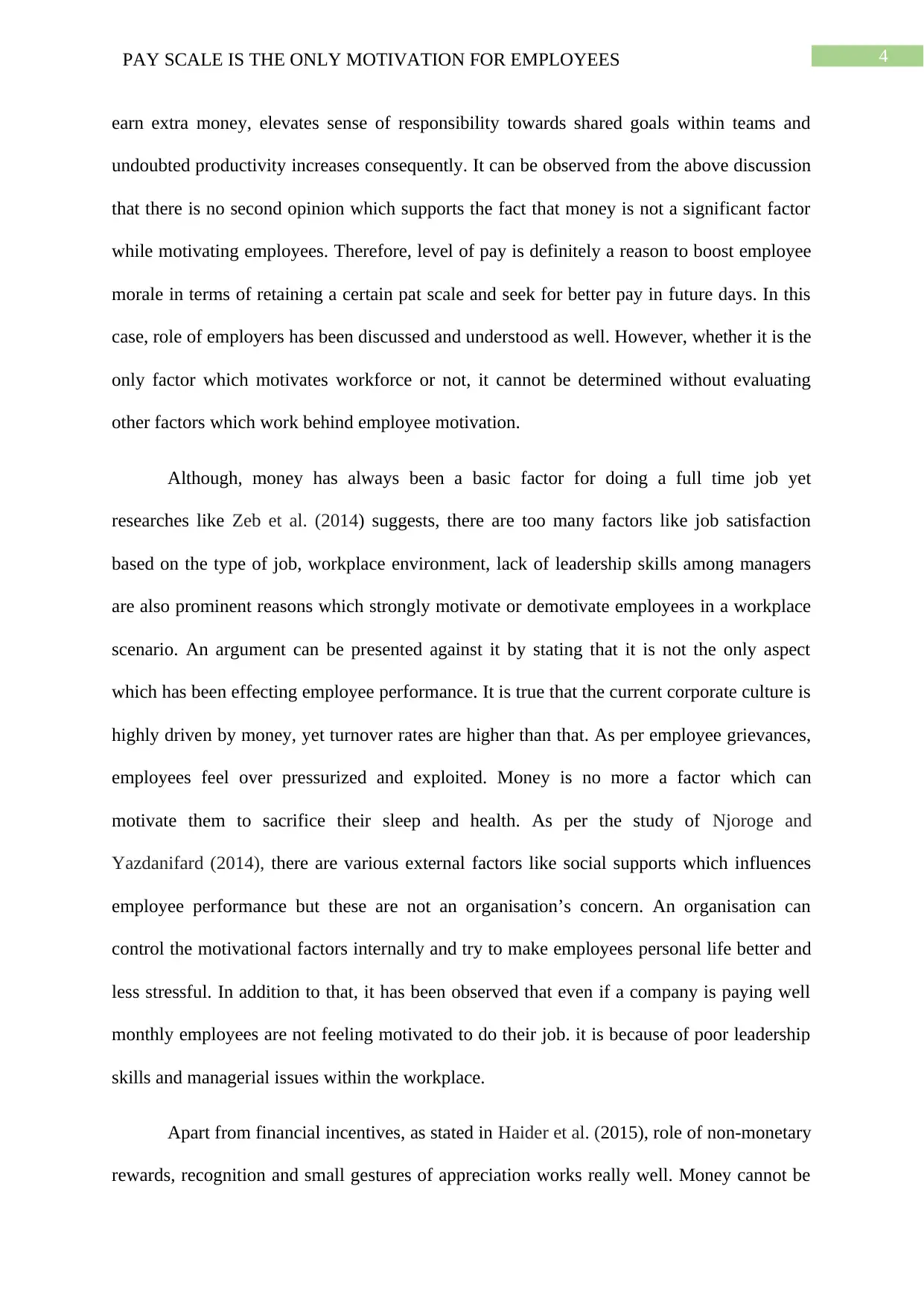
4PAY SCALE IS THE ONLY MOTIVATION FOR EMPLOYEES
earn extra money, elevates sense of responsibility towards shared goals within teams and
undoubted productivity increases consequently. It can be observed from the above discussion
that there is no second opinion which supports the fact that money is not a significant factor
while motivating employees. Therefore, level of pay is definitely a reason to boost employee
morale in terms of retaining a certain pat scale and seek for better pay in future days. In this
case, role of employers has been discussed and understood as well. However, whether it is the
only factor which motivates workforce or not, it cannot be determined without evaluating
other factors which work behind employee motivation.
Although, money has always been a basic factor for doing a full time job yet
researches like Zeb et al. (2014) suggests, there are too many factors like job satisfaction
based on the type of job, workplace environment, lack of leadership skills among managers
are also prominent reasons which strongly motivate or demotivate employees in a workplace
scenario. An argument can be presented against it by stating that it is not the only aspect
which has been effecting employee performance. It is true that the current corporate culture is
highly driven by money, yet turnover rates are higher than that. As per employee grievances,
employees feel over pressurized and exploited. Money is no more a factor which can
motivate them to sacrifice their sleep and health. As per the study of Njoroge and
Yazdanifard (2014), there are various external factors like social supports which influences
employee performance but these are not an organisation’s concern. An organisation can
control the motivational factors internally and try to make employees personal life better and
less stressful. In addition to that, it has been observed that even if a company is paying well
monthly employees are not feeling motivated to do their job. it is because of poor leadership
skills and managerial issues within the workplace.
Apart from financial incentives, as stated in Haider et al. (2015), role of non-monetary
rewards, recognition and small gestures of appreciation works really well. Money cannot be
earn extra money, elevates sense of responsibility towards shared goals within teams and
undoubted productivity increases consequently. It can be observed from the above discussion
that there is no second opinion which supports the fact that money is not a significant factor
while motivating employees. Therefore, level of pay is definitely a reason to boost employee
morale in terms of retaining a certain pat scale and seek for better pay in future days. In this
case, role of employers has been discussed and understood as well. However, whether it is the
only factor which motivates workforce or not, it cannot be determined without evaluating
other factors which work behind employee motivation.
Although, money has always been a basic factor for doing a full time job yet
researches like Zeb et al. (2014) suggests, there are too many factors like job satisfaction
based on the type of job, workplace environment, lack of leadership skills among managers
are also prominent reasons which strongly motivate or demotivate employees in a workplace
scenario. An argument can be presented against it by stating that it is not the only aspect
which has been effecting employee performance. It is true that the current corporate culture is
highly driven by money, yet turnover rates are higher than that. As per employee grievances,
employees feel over pressurized and exploited. Money is no more a factor which can
motivate them to sacrifice their sleep and health. As per the study of Njoroge and
Yazdanifard (2014), there are various external factors like social supports which influences
employee performance but these are not an organisation’s concern. An organisation can
control the motivational factors internally and try to make employees personal life better and
less stressful. In addition to that, it has been observed that even if a company is paying well
monthly employees are not feeling motivated to do their job. it is because of poor leadership
skills and managerial issues within the workplace.
Apart from financial incentives, as stated in Haider et al. (2015), role of non-monetary
rewards, recognition and small gestures of appreciation works really well. Money cannot be
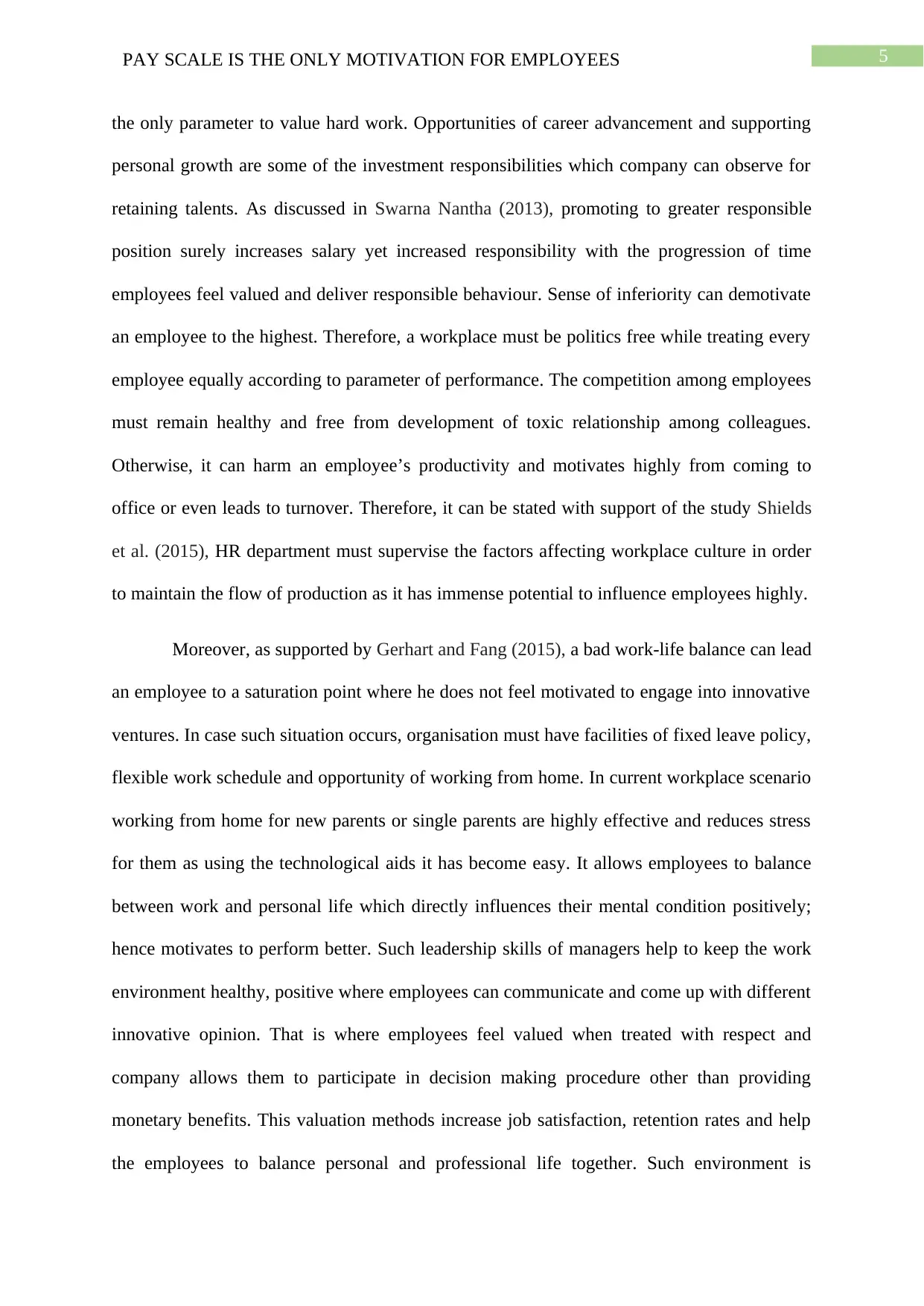
5PAY SCALE IS THE ONLY MOTIVATION FOR EMPLOYEES
the only parameter to value hard work. Opportunities of career advancement and supporting
personal growth are some of the investment responsibilities which company can observe for
retaining talents. As discussed in Swarna Nantha (2013), promoting to greater responsible
position surely increases salary yet increased responsibility with the progression of time
employees feel valued and deliver responsible behaviour. Sense of inferiority can demotivate
an employee to the highest. Therefore, a workplace must be politics free while treating every
employee equally according to parameter of performance. The competition among employees
must remain healthy and free from development of toxic relationship among colleagues.
Otherwise, it can harm an employee’s productivity and motivates highly from coming to
office or even leads to turnover. Therefore, it can be stated with support of the study Shields
et al. (2015), HR department must supervise the factors affecting workplace culture in order
to maintain the flow of production as it has immense potential to influence employees highly.
Moreover, as supported by Gerhart and Fang (2015), a bad work-life balance can lead
an employee to a saturation point where he does not feel motivated to engage into innovative
ventures. In case such situation occurs, organisation must have facilities of fixed leave policy,
flexible work schedule and opportunity of working from home. In current workplace scenario
working from home for new parents or single parents are highly effective and reduces stress
for them as using the technological aids it has become easy. It allows employees to balance
between work and personal life which directly influences their mental condition positively;
hence motivates to perform better. Such leadership skills of managers help to keep the work
environment healthy, positive where employees can communicate and come up with different
innovative opinion. That is where employees feel valued when treated with respect and
company allows them to participate in decision making procedure other than providing
monetary benefits. This valuation methods increase job satisfaction, retention rates and help
the employees to balance personal and professional life together. Such environment is
the only parameter to value hard work. Opportunities of career advancement and supporting
personal growth are some of the investment responsibilities which company can observe for
retaining talents. As discussed in Swarna Nantha (2013), promoting to greater responsible
position surely increases salary yet increased responsibility with the progression of time
employees feel valued and deliver responsible behaviour. Sense of inferiority can demotivate
an employee to the highest. Therefore, a workplace must be politics free while treating every
employee equally according to parameter of performance. The competition among employees
must remain healthy and free from development of toxic relationship among colleagues.
Otherwise, it can harm an employee’s productivity and motivates highly from coming to
office or even leads to turnover. Therefore, it can be stated with support of the study Shields
et al. (2015), HR department must supervise the factors affecting workplace culture in order
to maintain the flow of production as it has immense potential to influence employees highly.
Moreover, as supported by Gerhart and Fang (2015), a bad work-life balance can lead
an employee to a saturation point where he does not feel motivated to engage into innovative
ventures. In case such situation occurs, organisation must have facilities of fixed leave policy,
flexible work schedule and opportunity of working from home. In current workplace scenario
working from home for new parents or single parents are highly effective and reduces stress
for them as using the technological aids it has become easy. It allows employees to balance
between work and personal life which directly influences their mental condition positively;
hence motivates to perform better. Such leadership skills of managers help to keep the work
environment healthy, positive where employees can communicate and come up with different
innovative opinion. That is where employees feel valued when treated with respect and
company allows them to participate in decision making procedure other than providing
monetary benefits. This valuation methods increase job satisfaction, retention rates and help
the employees to balance personal and professional life together. Such environment is
⊘ This is a preview!⊘
Do you want full access?
Subscribe today to unlock all pages.

Trusted by 1+ million students worldwide
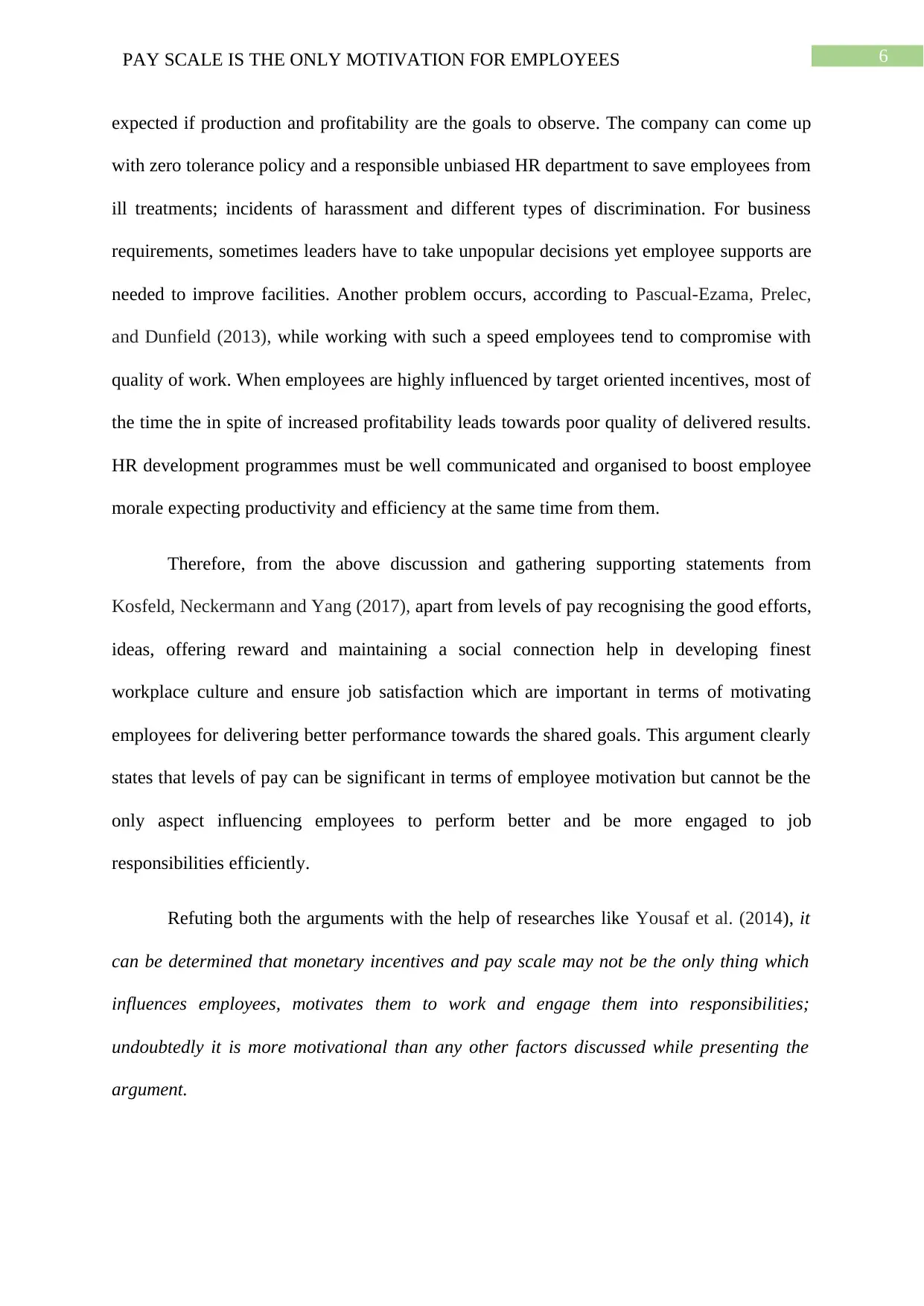
6PAY SCALE IS THE ONLY MOTIVATION FOR EMPLOYEES
expected if production and profitability are the goals to observe. The company can come up
with zero tolerance policy and a responsible unbiased HR department to save employees from
ill treatments; incidents of harassment and different types of discrimination. For business
requirements, sometimes leaders have to take unpopular decisions yet employee supports are
needed to improve facilities. Another problem occurs, according to Pascual-Ezama, Prelec,
and Dunfield (2013), while working with such a speed employees tend to compromise with
quality of work. When employees are highly influenced by target oriented incentives, most of
the time the in spite of increased profitability leads towards poor quality of delivered results.
HR development programmes must be well communicated and organised to boost employee
morale expecting productivity and efficiency at the same time from them.
Therefore, from the above discussion and gathering supporting statements from
Kosfeld, Neckermann and Yang (2017), apart from levels of pay recognising the good efforts,
ideas, offering reward and maintaining a social connection help in developing finest
workplace culture and ensure job satisfaction which are important in terms of motivating
employees for delivering better performance towards the shared goals. This argument clearly
states that levels of pay can be significant in terms of employee motivation but cannot be the
only aspect influencing employees to perform better and be more engaged to job
responsibilities efficiently.
Refuting both the arguments with the help of researches like Yousaf et al. (2014), it
can be determined that monetary incentives and pay scale may not be the only thing which
influences employees, motivates them to work and engage them into responsibilities;
undoubtedly it is more motivational than any other factors discussed while presenting the
argument.
expected if production and profitability are the goals to observe. The company can come up
with zero tolerance policy and a responsible unbiased HR department to save employees from
ill treatments; incidents of harassment and different types of discrimination. For business
requirements, sometimes leaders have to take unpopular decisions yet employee supports are
needed to improve facilities. Another problem occurs, according to Pascual-Ezama, Prelec,
and Dunfield (2013), while working with such a speed employees tend to compromise with
quality of work. When employees are highly influenced by target oriented incentives, most of
the time the in spite of increased profitability leads towards poor quality of delivered results.
HR development programmes must be well communicated and organised to boost employee
morale expecting productivity and efficiency at the same time from them.
Therefore, from the above discussion and gathering supporting statements from
Kosfeld, Neckermann and Yang (2017), apart from levels of pay recognising the good efforts,
ideas, offering reward and maintaining a social connection help in developing finest
workplace culture and ensure job satisfaction which are important in terms of motivating
employees for delivering better performance towards the shared goals. This argument clearly
states that levels of pay can be significant in terms of employee motivation but cannot be the
only aspect influencing employees to perform better and be more engaged to job
responsibilities efficiently.
Refuting both the arguments with the help of researches like Yousaf et al. (2014), it
can be determined that monetary incentives and pay scale may not be the only thing which
influences employees, motivates them to work and engage them into responsibilities;
undoubtedly it is more motivational than any other factors discussed while presenting the
argument.
Paraphrase This Document
Need a fresh take? Get an instant paraphrase of this document with our AI Paraphraser
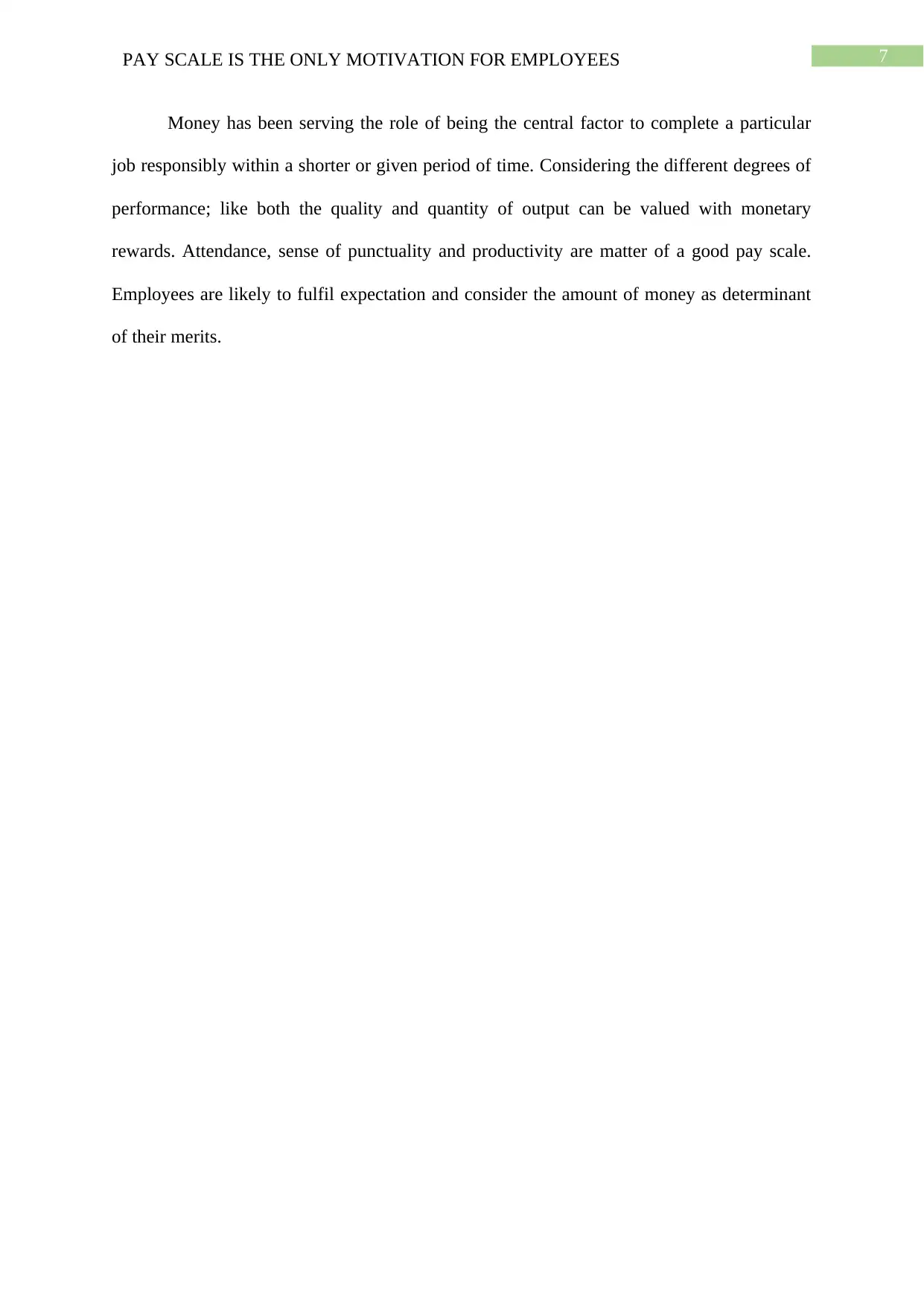
7PAY SCALE IS THE ONLY MOTIVATION FOR EMPLOYEES
Money has been serving the role of being the central factor to complete a particular
job responsibly within a shorter or given period of time. Considering the different degrees of
performance; like both the quality and quantity of output can be valued with monetary
rewards. Attendance, sense of punctuality and productivity are matter of a good pay scale.
Employees are likely to fulfil expectation and consider the amount of money as determinant
of their merits.
Money has been serving the role of being the central factor to complete a particular
job responsibly within a shorter or given period of time. Considering the different degrees of
performance; like both the quality and quantity of output can be valued with monetary
rewards. Attendance, sense of punctuality and productivity are matter of a good pay scale.
Employees are likely to fulfil expectation and consider the amount of money as determinant
of their merits.
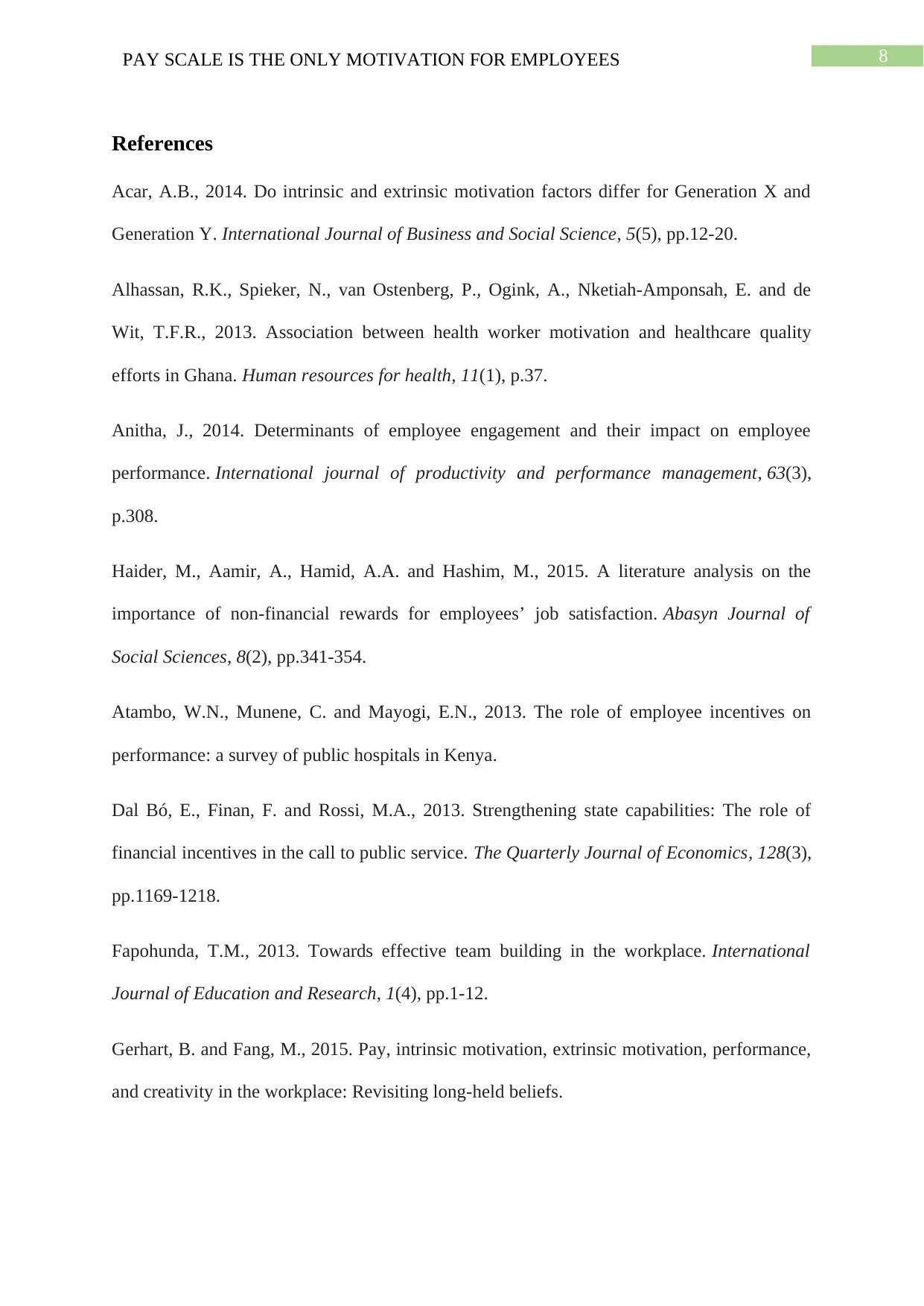
8PAY SCALE IS THE ONLY MOTIVATION FOR EMPLOYEES
References
Acar, A.B., 2014. Do intrinsic and extrinsic motivation factors differ for Generation X and
Generation Y. International Journal of Business and Social Science, 5(5), pp.12-20.
Alhassan, R.K., Spieker, N., van Ostenberg, P., Ogink, A., Nketiah-Amponsah, E. and de
Wit, T.F.R., 2013. Association between health worker motivation and healthcare quality
efforts in Ghana. Human resources for health, 11(1), p.37.
Anitha, J., 2014. Determinants of employee engagement and their impact on employee
performance. International journal of productivity and performance management, 63(3),
p.308.
Haider, M., Aamir, A., Hamid, A.A. and Hashim, M., 2015. A literature analysis on the
importance of non-financial rewards for employees’ job satisfaction. Abasyn Journal of
Social Sciences, 8(2), pp.341-354.
Atambo, W.N., Munene, C. and Mayogi, E.N., 2013. The role of employee incentives on
performance: a survey of public hospitals in Kenya.
Dal Bó, E., Finan, F. and Rossi, M.A., 2013. Strengthening state capabilities: The role of
financial incentives in the call to public service. The Quarterly Journal of Economics, 128(3),
pp.1169-1218.
Fapohunda, T.M., 2013. Towards effective team building in the workplace. International
Journal of Education and Research, 1(4), pp.1-12.
Gerhart, B. and Fang, M., 2015. Pay, intrinsic motivation, extrinsic motivation, performance,
and creativity in the workplace: Revisiting long-held beliefs.
References
Acar, A.B., 2014. Do intrinsic and extrinsic motivation factors differ for Generation X and
Generation Y. International Journal of Business and Social Science, 5(5), pp.12-20.
Alhassan, R.K., Spieker, N., van Ostenberg, P., Ogink, A., Nketiah-Amponsah, E. and de
Wit, T.F.R., 2013. Association between health worker motivation and healthcare quality
efforts in Ghana. Human resources for health, 11(1), p.37.
Anitha, J., 2014. Determinants of employee engagement and their impact on employee
performance. International journal of productivity and performance management, 63(3),
p.308.
Haider, M., Aamir, A., Hamid, A.A. and Hashim, M., 2015. A literature analysis on the
importance of non-financial rewards for employees’ job satisfaction. Abasyn Journal of
Social Sciences, 8(2), pp.341-354.
Atambo, W.N., Munene, C. and Mayogi, E.N., 2013. The role of employee incentives on
performance: a survey of public hospitals in Kenya.
Dal Bó, E., Finan, F. and Rossi, M.A., 2013. Strengthening state capabilities: The role of
financial incentives in the call to public service. The Quarterly Journal of Economics, 128(3),
pp.1169-1218.
Fapohunda, T.M., 2013. Towards effective team building in the workplace. International
Journal of Education and Research, 1(4), pp.1-12.
Gerhart, B. and Fang, M., 2015. Pay, intrinsic motivation, extrinsic motivation, performance,
and creativity in the workplace: Revisiting long-held beliefs.
⊘ This is a preview!⊘
Do you want full access?
Subscribe today to unlock all pages.

Trusted by 1+ million students worldwide
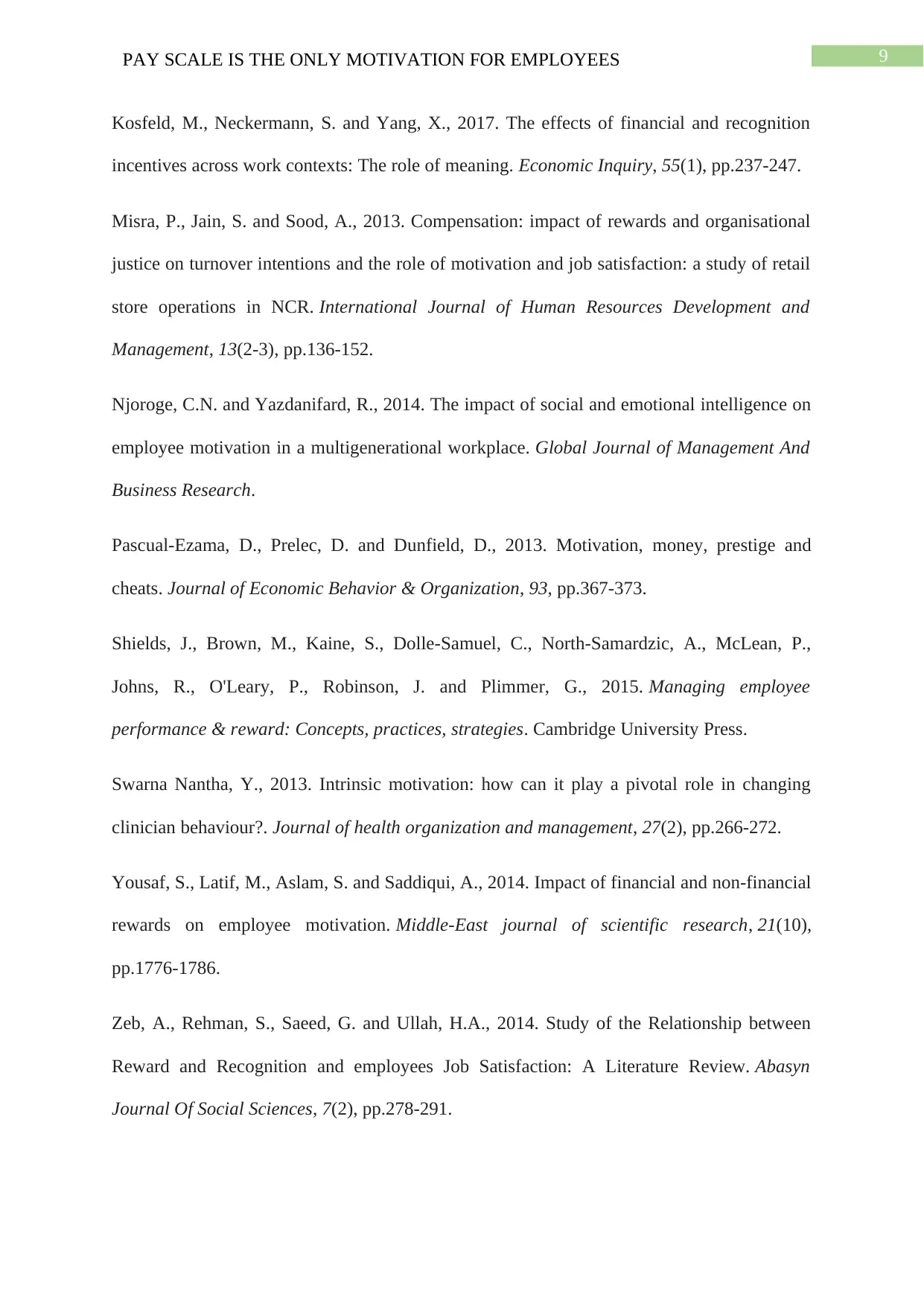
9PAY SCALE IS THE ONLY MOTIVATION FOR EMPLOYEES
Kosfeld, M., Neckermann, S. and Yang, X., 2017. The effects of financial and recognition
incentives across work contexts: The role of meaning. Economic Inquiry, 55(1), pp.237-247.
Misra, P., Jain, S. and Sood, A., 2013. Compensation: impact of rewards and organisational
justice on turnover intentions and the role of motivation and job satisfaction: a study of retail
store operations in NCR. International Journal of Human Resources Development and
Management, 13(2-3), pp.136-152.
Njoroge, C.N. and Yazdanifard, R., 2014. The impact of social and emotional intelligence on
employee motivation in a multigenerational workplace. Global Journal of Management And
Business Research.
Pascual-Ezama, D., Prelec, D. and Dunfield, D., 2013. Motivation, money, prestige and
cheats. Journal of Economic Behavior & Organization, 93, pp.367-373.
Shields, J., Brown, M., Kaine, S., Dolle-Samuel, C., North-Samardzic, A., McLean, P.,
Johns, R., O'Leary, P., Robinson, J. and Plimmer, G., 2015. Managing employee
performance & reward: Concepts, practices, strategies. Cambridge University Press.
Swarna Nantha, Y., 2013. Intrinsic motivation: how can it play a pivotal role in changing
clinician behaviour?. Journal of health organization and management, 27(2), pp.266-272.
Yousaf, S., Latif, M., Aslam, S. and Saddiqui, A., 2014. Impact of financial and non-financial
rewards on employee motivation. Middle-East journal of scientific research, 21(10),
pp.1776-1786.
Zeb, A., Rehman, S., Saeed, G. and Ullah, H.A., 2014. Study of the Relationship between
Reward and Recognition and employees Job Satisfaction: A Literature Review. Abasyn
Journal Of Social Sciences, 7(2), pp.278-291.
Kosfeld, M., Neckermann, S. and Yang, X., 2017. The effects of financial and recognition
incentives across work contexts: The role of meaning. Economic Inquiry, 55(1), pp.237-247.
Misra, P., Jain, S. and Sood, A., 2013. Compensation: impact of rewards and organisational
justice on turnover intentions and the role of motivation and job satisfaction: a study of retail
store operations in NCR. International Journal of Human Resources Development and
Management, 13(2-3), pp.136-152.
Njoroge, C.N. and Yazdanifard, R., 2014. The impact of social and emotional intelligence on
employee motivation in a multigenerational workplace. Global Journal of Management And
Business Research.
Pascual-Ezama, D., Prelec, D. and Dunfield, D., 2013. Motivation, money, prestige and
cheats. Journal of Economic Behavior & Organization, 93, pp.367-373.
Shields, J., Brown, M., Kaine, S., Dolle-Samuel, C., North-Samardzic, A., McLean, P.,
Johns, R., O'Leary, P., Robinson, J. and Plimmer, G., 2015. Managing employee
performance & reward: Concepts, practices, strategies. Cambridge University Press.
Swarna Nantha, Y., 2013. Intrinsic motivation: how can it play a pivotal role in changing
clinician behaviour?. Journal of health organization and management, 27(2), pp.266-272.
Yousaf, S., Latif, M., Aslam, S. and Saddiqui, A., 2014. Impact of financial and non-financial
rewards on employee motivation. Middle-East journal of scientific research, 21(10),
pp.1776-1786.
Zeb, A., Rehman, S., Saeed, G. and Ullah, H.A., 2014. Study of the Relationship between
Reward and Recognition and employees Job Satisfaction: A Literature Review. Abasyn
Journal Of Social Sciences, 7(2), pp.278-291.
Paraphrase This Document
Need a fresh take? Get an instant paraphrase of this document with our AI Paraphraser

10PAY SCALE IS THE ONLY MOTIVATION FOR EMPLOYEES
1 out of 11
Related Documents
Your All-in-One AI-Powered Toolkit for Academic Success.
+13062052269
info@desklib.com
Available 24*7 on WhatsApp / Email
![[object Object]](/_next/static/media/star-bottom.7253800d.svg)
Unlock your academic potential
Copyright © 2020–2025 A2Z Services. All Rights Reserved. Developed and managed by ZUCOL.





